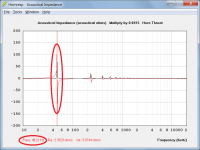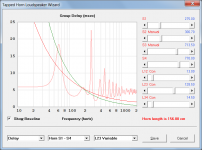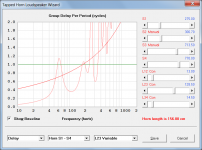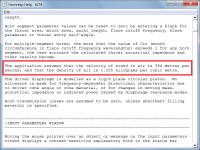Hi freddi,
Try removing the segment 4 mouth area S5 value of 8.00. Hopefully this will fix the problem.
The segment 3 mouth area S4 value of 437.00 should have been automatically copied down as the segment 4 throat area S4 when 8.00 was entered into S5. I have no idea why this did not happen. Please let me know if you still have a problem.
Kind regards,
David
Try removing the segment 4 mouth area S5 value of 8.00. Hopefully this will fix the problem.
The segment 3 mouth area S4 value of 437.00 should have been automatically copied down as the segment 4 throat area S4 when 8.00 was entered into S5. I have no idea why this did not happen. Please let me know if you still have a problem.
Kind regards,
David
Hi all,
i'd like to calculate the fundamental frequency of an empty(no dampening) negative expanding parabolic horn by an equotiation.
Eg:
S1=1000cm^2
S2=100cm^2
L12=100cm
Fb=?
Any advice is welcome, thanks in advance!
rertrobaer
Hi rertrobaer,
As indicated in my earlier email reply, I very much doubt that there is a simple equation that will give you what you want.
The throat (S1) acoustical impedance for your given example is shown in the attachment, assuming 2 Pi radiation conditions at the mouth (S2). The fundamental resonance for your example would therefore appear to be about 48 hertz.
Calculating pressure and volume velocity values for a tapered parabolic horn is not a trivial task. The expressions for the transmission coefficients of a negative flare parabolic horn are relatively complex - they contain Bessel functions of the first and second kind, with orders of zero and one (ie. J0(x), J1(x), Y0(x) and Y1(x)). If you are really keen, all the parabolic horn equations are given in the book "Acoustics - Sound Fields and Transducers", by Beranek and Mellow.
Kind regards,
David
Attachments
The throat (S1) acoustical impedance for your given example is shown in the attachment, assuming 2 Pi radiation conditions at the mouth (S2). The fundamental resonance for your example would therefore appear to be about 48 hertz.
Thanks, interresting. In "Louspeaker Wizard", 46,9Hz are shown in the "acoustical power" window. Is this because it is a pre-calculation?
I was in the hope there is something like l=c/Fb/4 which works for non-expanding horns(ignoring the open end boundary).Calculating pressure and volume velocity values for a tapered parabolic horn is not a trivial task. The expressions for the transmission coefficients of a negative flare parabolic horn are relatively complex - they contain Bessel functions of the first and second kind, with orders of zero and one (ie. J0(x), J1(x), Y0(x) and Y1(x)). If you are really keen, all the parabolic horn equations are given in the book "Acoustics - Sound Fields and Transducers", by Beranek and Mellow.
Thanks for the book hint. I doubt i'm smart enough, but maybe i'll try ...
Rertrobaer
The attachments show a representative example (H-Frame) design.
Hi David
Sorry, I am new in this thread . I tried to read the last 50..200 answers, but without success...
Few ours ago I was able to have a new record and reproduce an H-Frame like your example. But now I'm typing in your data and always get an error L56=0,00. Indenpendend of the sequence of input or setting "CH".
I'm running 4510-180608 version.
And one more question. How can I arrange 2 H-Frames with L12 like 0,01 (that meens No-Frame) parallel at a distance between them of 17cm.
best regards
Wolfgang
Hi Rertrobaer,
I used Ang = 2.0 x Pi in my example. It would appear that you are using Ang = 1.0 x Pi.
Unfortunately it is not quite as simple as that .
.
Kind regards,
David
In "Louspeaker Wizard", 46,9Hz are shown in the "acoustical power" window.
I used Ang = 2.0 x Pi in my example. It would appear that you are using Ang = 1.0 x Pi.
I was in the hope there is something like l=c/Fb/4 which works for non-expanding horns(ignoring the open end boundary).
Unfortunately it is not quite as simple as that
Kind regards,
David
Hi Wolfgang,
It would seem that you have not entered a value in the compound horn L56 input box. Assuming that you wanted to specify a conical segment of length 20cm, click on the L56 input box in edit mode to highlight the box, and then type C20 and press the Enter key.
I am not sure that I understand exactly what it is that you have in mind, but I suspect that it cannot be simulated using Hornresp.
Kind regards,
David
Few ours ago I was able to have a new record and reproduce an H-Frame like your example. But now I'm typing in your data and always get an error L56=0,00. Indenpendend of the sequence of input or setting "CH".
It would seem that you have not entered a value in the compound horn L56 input box. Assuming that you wanted to specify a conical segment of length 20cm, click on the L56 input box in edit mode to highlight the box, and then type C20 and press the Enter key.
How can I arrange 2 H-Frames with L12 like 0,01 (that meens No-Frame) parallel at a distance between them of 17cm.
I am not sure that I understand exactly what it is that you have in mind, but I suspect that it cannot be simulated using Hornresp.
Kind regards,
David
oh David - my vision isn't so good - thought that was a "zero"
Hi freddi,
That was easy fixed - although I still don't understand how you managed to get the "stand-alone" 8 in there in the first place
Sorry to hear about your "dodgy" eyesight.
Kind regards,
David
Hornresp Update 4520-180612
Hi Everyone,
CHANGE
1/f and Claus Futtrup guideline limits can now be added to the loudspeaker and filter wizard group delay charts.
Double-click anywhere on the group delay chart Y-axis vertical scale to add a green 1/f limit line. Double-click again to add a red Claus Futtrup limit guideline. Double-click a third time to remove the 1/f limit line and double-click a fourth time to remove the Claus Futtrup limit guideline.
The Claus Futtrup audible group delay threshold limit guideline in milliseconds is given by the expression:
GDlimit = 1000 * 1.1606 / (5.6413 * f ^ 0.81511 - f)
Where f is the frequency in hertz.
Kind regards,
David
Hi Everyone,
CHANGE
1/f and Claus Futtrup guideline limits can now be added to the loudspeaker and filter wizard group delay charts.
Double-click anywhere on the group delay chart Y-axis vertical scale to add a green 1/f limit line. Double-click again to add a red Claus Futtrup limit guideline. Double-click a third time to remove the 1/f limit line and double-click a fourth time to remove the Claus Futtrup limit guideline.
The Claus Futtrup audible group delay threshold limit guideline in milliseconds is given by the expression:
GDlimit = 1000 * 1.1606 / (5.6413 * f ^ 0.81511 - f)
Where f is the frequency in hertz.
Kind regards,
David
Attachments
Hi,
Ok, so this fundemantal freq is reliable.
Do you use speed of sound c=340m/s in hornresp for calculation? Is there a open bound correction added(0.5*sqrt(S2/pi)) ?
Sorry if this all has been asked already, but this thread is so very long ;-)
Retrorbaer
I used Ang = 2.0 x Pi in my example. It would appear that you are using Ang = 1.0 x Pi.
Ok, so this fundemantal freq is reliable.
Do you use speed of sound c=340m/s in hornresp for calculation? Is there a open bound correction added(0.5*sqrt(S2/pi)) ?
Sorry if this all has been asked already, but this thread is so very long ;-)
Retrorbaer
Hi Retrorbaer,
Hornresp assumes that the velocity of sound in air is 344 metres per second, and that the density of air is 1.205 kilograms per cubic metre. It's all in the Help file .
.
An end correction is not applicable because Hornresp takes into account the actual acoustical impedance loading the horn mouth. (The purpose of an end correction is simply to approximate the effect of a terminating impedance).
Kind regards,
David
Hornresp assumes that the velocity of sound in air is 344 metres per second, and that the density of air is 1.205 kilograms per cubic metre. It's all in the Help file
An end correction is not applicable because Hornresp takes into account the actual acoustical impedance loading the horn mouth. (The purpose of an end correction is simply to approximate the effect of a terminating impedance).
Kind regards,
David
Attachments
Hi Etocynned,
I guess you could think of it that way, but it all hinges on what you are really trying to achieve. As far as Hornresp is concerned, the multiple drivers in a vented box system are modelled as a single composite driver that "sees" the complete chamber and port tube.
Why do you ask the question - just out of general curiosity, or did you have something specific in mind?
Kind regards,
David
I guess you could think of it that way, but it all hinges on what you are really trying to achieve. As far as Hornresp is concerned, the multiple drivers in a vented box system are modelled as a single composite driver that "sees" the complete chamber and port tube.
Why do you ask the question - just out of general curiosity, or did you have something specific in mind?
Kind regards,
David
Found it
Sorry to bother you, I found the error in my script. Now I only have rounding error on the fifth or sixth decimal.
Hi David
How do you calculate the angle horn angle?
I'm sitting here with formula for a hypex horn, trying to calculate the angle, but we are not on the same page. Do you use some numeric derivation or have you found the true derivative of the function?
Sorry to bother you, I found the error in my script. Now I only have rounding error on the fifth or sixth decimal.
- Home
- Loudspeakers
- Subwoofers
- Hornresp




